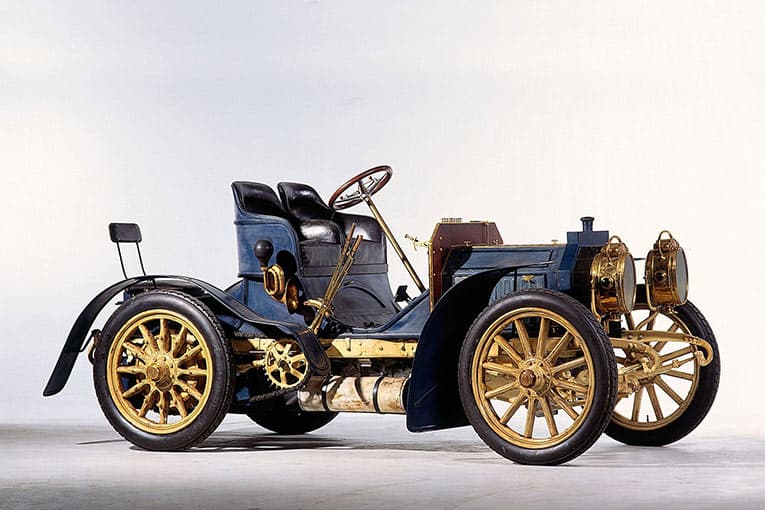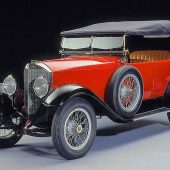The Austrian businessman Emil Jellinek, who was known as Monsieur Mercedes, was virtually addicted to technical progress of the newly invented car. In March 1900, he entered two Daimler Phoenix racing cars in the Nice race week under the name Mercedes, the name of his daughter, who was ten at the time.
In April 1900, Jallinek demanded a more competitive car from Daimler-Motoren-Gesellschaft (DMG) with higher performance and longer wheelbase than the Phoenix race car, but at the same time it should have a lighter engine and lower centre of gravity. Also, the newly developed engine was to bear the name Daimler-Mercedes. In Jellinek’s opinion, the only one capable of realizing his ideas was Wilhelm Maybach, the ingenious technical brain of DMG. To give emphasis to his detailed wishes, Jellinek ordered 36 vehicles from DMG.
Only an extensively new design came into consideration for the car demanded by Jellinek. First of all, Maybach developed the new engine for the Mercedes car. With a bore/stroke ratio of 116 x 140 mm, the engine had a total displacement of 5918cc and output of around 35 hp. Engines weight was reduced by 90 kg to around 230 kg. Maybach no longer installed the engine into a chassis sub frame, as was usually the case at that time. Instead, he narrowed the front frame section ahead of the pedal level, permitting the engine to be directly bolted to the side members. The latter were no longer laboriously beaded but for the first time made of pressed sheet steel by DMG. Both these measures not only reduced the weight but also provided for the lower center of gravity that Maybach was aiming at.
Another completely new design was the highly compact and automatically adjusting clutch, a coil spring made of spring steel, which with the help of a small drum was attached to the transmission shaft and fastened inside the flywheel. Further development of the car at a later stage benefited from this design. A conical cam regulated the spring tension during declutching.

The four forward gears and the reverse gear were engaged by means of a single lever in a shift gate. This feature was as new as the improved, light steering with its worm gear, a unit installed further to the rear and at a relatively steep angle. The steering axles were moved further toward the outside, closer to the wheel hubs, thereby significantly reducing the impact of road shocks on the steering.
Compared to the Phoenix car, the wheelbase was markedly longer at 2245 millimetres and the track wider at 1400 mm. This improved the car’s stability significantly. Wheels of virtually the same size were now used on the two axles, but they still featured the traditional wooden twelve-spoke design. The brakes were adapted to the higher engine output. Daimler 35 hp Mercedes was fitted with 30 centimetre drum brakes on the rear wheels, operated via a manual lever and a linkage, and with an additional foot-operated brake.
One of the most sensational inventions, which have essentially remained unchanged to this day, was the honeycomb radiator. Until then, coiled pipe radiators had customarily been used, their efficiency leaving much to be desired. They had caused an enormous water consumption or required very large and therefore heavy coolant circuits. Maybach had taken a major step toward the solution of the cooling problem as early as 1897 when he introduced a radiator consisting of a large number of small tubes which were flushed by coolant and additionally cooled by airflow. The latter permitted a marked reduction in the required coolant reservoir which, however, was still a sizeable 18 liters.
Maybach achieved a major breakthrough with the honeycomb radiator first incorporated in the Mercedes. He had as many as 8,070 small square tubes, each six by six millimeters in size, soldered together into a completely novel, rectangular radiator. Cooling efficiency was considerably increased and water consumption reduced by half to a mere nine litres by the square tubes’ larger passage cross-section and the smaller gaps between the tubes. A small fan behind the radiator improved cooling efficiency at slow speeds.
The sensational successes in racing in 1901 of the Mercedes cars gave credit to Maybach’s new design. People also highly appreciated the fact that the two-seater, once it was no longer used for racing, was easily converted into an elegant four-seater by means of a rear bodywork element that could be installed in just a few minutes. DMG was more than happy about the success of the 35 hp car. As early as March 1901, the product range was ex¬tended by the addition of the smaller 12/16 hp Mercedes and in August by a third model, the 8/11 hp Mercedes. Maybach began further developing the first Mercedes series in the fall of 1901 already. To start with, the 40 hp Mercedes-Simplex was designed as a new top model and direct successor to the 35 hp Mercedes.









